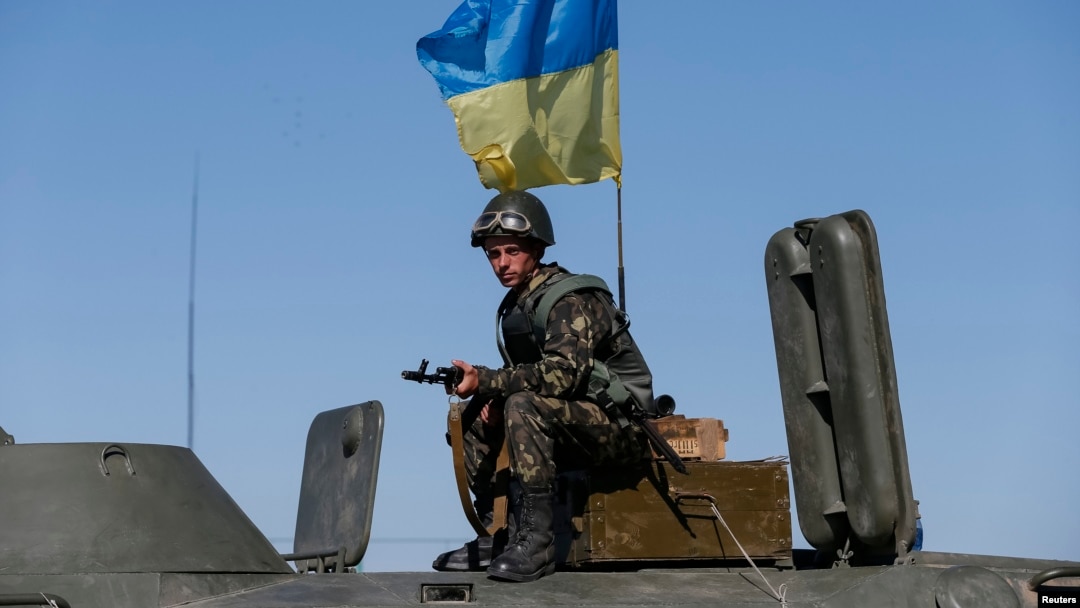A cease-fire has come into force in eastern Ukraine after almost five months of fighting.
Earlier on September 5 in the Belarusian capital, Minsk, Ukrainian officials and pro-Russian separatists agreed to stop firing at 1800 local time.
Ukrainian President Petro Poroshenko said he would do "everything possible and impossible" to end the bloodshed.
A top separatist leader said the truce doesn’t changed the rebels’ policy of advocating separation from Ukraine.
The Kremlin said it “hails” the agreement and expressed hopes the sides will be strictly abided by the agreements.
Heidi Tagliavini of the Organization for Security and Cooperation in Europe (OSCE) said the truce agreement included a cessation of fire, a troop withdrawal, a prisoner exchange, and the provision of humanitarian aid.
Poroshenko said the prisoner swap could start as early as September 6.
The Minsk talks, which involved representatives of Russia and the OSCE, follow a telephone conversation between Poroshenko and Russian President Vladimir Putin on September 3.
The breakthrough in Minsk follows two weeks of separatist gains which NATO says were made with the direct involvement of thousands of Russian troops as well as military hardware. Russia denies this.
Despite the deal, the EU agreed stronger sanctions against Russia over its role in eastern Ukraine and the measures are to be implemented on September 8.
Diplomats say the fresh sanctions include an expanded list of officials under an EU travel ban and asset freeze, plus credit restrictions to Russian companies as well as an export ban on dual-use goods.
According to EU diplomats, Russia's Gazprom Bank and Gazprom Neft would fall under the new ban on raising capital in the EU.
However, diplomats said the sanctions could be suspended if a cease-fire between Kyiv and pro-Russia rebels agreed earlier on September 5 would hold and if Moscow withdraws its troops from Ukraine.
Your browser doesn’t support HTML5
Obama Says NATO Will Provide Security Assistance To Ukraine
WATCH: Obama Says NATO Will Provide Security Assistance To Ukraine
At a NATO summit in Britain on September 5, U.S. President Barak Obama said he was hopeful but skeptical about the cease-fire agreement, and called on European allies to agree on new sanctions against Russia that could be suspended if the peace plan holds.
German Chancellor Angela Merkel said on September 5 new EU sanctions could be suspended if a cease-fire holds in eastern Ukraine.
At a NATO summit in Britain, NATO Secretary-General Anders Fogh Rasmussen on September 4 cautioned that previous Russian cease-fire initiatives had proven to be "smoke screens for the continued destabilization of Ukraine."
Hours before the cease-fire agreement was announced, fighting continued between Ukrainian government forces and the separatists east of the strategic port of Mariupol, in southeastern Ukraine.
There were also reports of sustained shelling and artillery fire near the city of Donetsk, one of the major strongholds of the rebels.
Your browser doesn’t support HTML5
Ukrainian Protesters Hold Mock Funeral With Putin Effigy
WATCH: A crowd protesting Russian military action in Ukraine held a mock funeral with an effigy of Russian President Vladimir Putin in the eastern Ukrainian city of Kharkiv on September 4. The coffin was taken to the Russian Consulate.
An RFE/RL correspondent in Mariupol says local residents were preparing bomb shelters ahead of what many feared would be a separatist attack on the city, but that the situation inside the city itself was calm on September 5.
Ukrainian pro-government forces said they had come under fire several times during the night east of Mariupol, where OSCE observers reported heavy fighting in two villages on September 4 .
Mariupol, a strategic port city on the Azov Sea west of the Russian border, would be a big prize for rebels who hold the provincial capitals of Donetsk and Luhansk and have gained ground across southeastern Ukraine recently after appearing on the verge of defeat just weeks ago.
Rebels recently occupied a town between Mariupol and the Russian border, and government forces in the city have been bracing for an attack.


